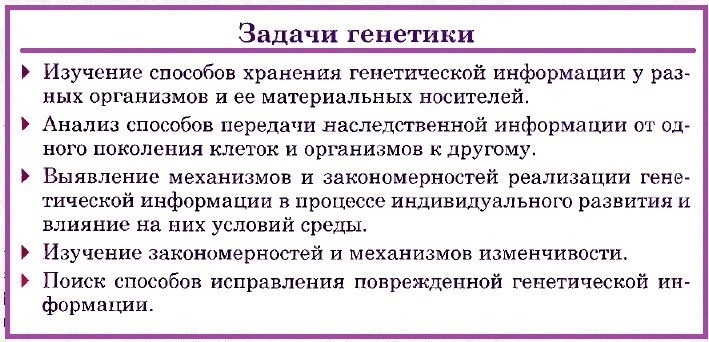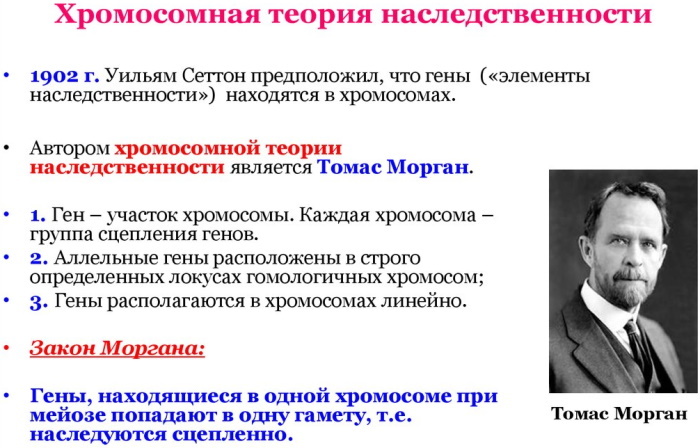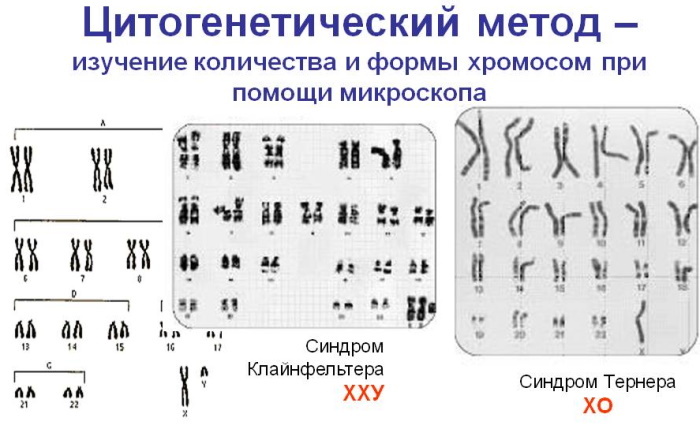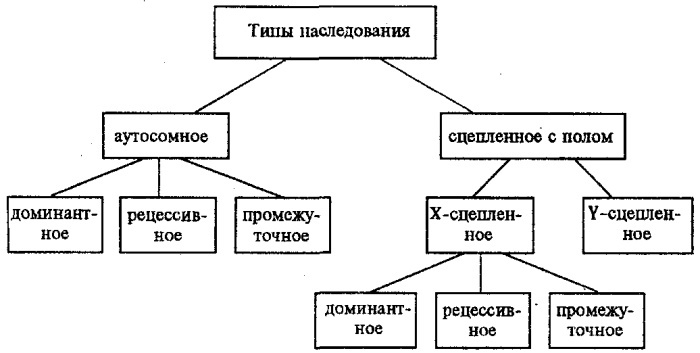Heredity is one of the fundamental concepts in genetics as a branch of biological science that studies the principles and patterns of transmission of certain traits from generation to generation. Genetics considers inheritance in animals, plants, microorganisms and humans.
Record content:
- 1 Basic concepts of human heredity in biology
-
2 Types of heredity
- 2.1 Nuclear or chromosomal inheritance
- 2.2 Cytoplasmic or non-chromosomal inheritance
- 3 Carriers of heredity
-
4 Genetic methods
- 4.1 Genealogical method
- 4.2 Twin method
- 4.3 Cytogenetic method
- 4.4 Biochemical method
- 4.5 Population-static method
- 5 Genetic symbolism
- 6 Sex chromosomes, conflict
- 7 Autosomal and sex-linked traits
- 8 Videos about heredity in biology
Basic concepts of human heredity in biology
Bisexual reproduction is a complex process involving, respectively, two living organisms. Each of them has its own unique set of genetic and external parameters.
The basic concepts of heredity are:
- genotype and phenotype;
- DNA;
- gene;
- alleles;
- dominance;
- dominant and recessive;
- homozygous and heterozygous.
External parameters or signs are manifested directly in the phenotype (appearance, appearance) of the creature. So, for example, a trait that manifested itself phenotypically is the blue color of a woman's eyes.
Many signs appear not only externally, but are also recorded in the genotype of the organism. The genotype is a complex structure that has not yet been fully studied by modern scientists.
The genotype is the sum of genes belonging directly to the individual under consideration. Genes are a unit of hereditary information transmitted using DNA. This method of transmission is characteristic only of living organisms. Those that reproduce bisexually.
DNA is present in organisms and the simplest creatures. Such as unicellular fungi and plants that reproduce through parthenogenesis - unisexual (asexual) reproduction. The main characteristic of asexual reproduction is the absence of gametes, sex cells, which, when combined, become an embryo.
Asexual reproduction is based on the process of mitosis. Simply put, this is a doubling of the genetic chain and division into two identical parts. One part of the DNA will remain in the mother's body, and the second will become the basis of the new one.
Mitosis is the simplest process that is inherent in the simplest organisms (eukaryotes) and requires much less energy than sexual reproduction. In mitosis, there are no such phases of DNA restructuring as exchange of sites and conjugation.
The result of asexual reproduction is "clones" - creatures that exactly repeat the genotype and phenotype of the parent organism. Clones are also called "daughter" organisms.
This is the lack of mitotic division. As a result of the simplest reproduction, new evolutionarily important characteristics of the organism do not appear, while during sexual reproduction, the characteristics are not only inherited, but also give rise to new ones.
One gene can be represented by different alleles. The gene that is responsible for the color of the eyes of the unborn child is represented by the following alleles: blue, green, brown, gray.
That is, these are options for representing the same parameter. In this case, the parameter is the eye color. Thus, an allele is a form of one gene that is located on the same sections of the chromosomes of parental organisms.
Inherited parameters, alleles, can be dominant or recessive. Dominance is a form of interaction in which one gene is overwhelming, dominant, does not allow a recessive, weak gene to manifest itself.
The dominant gene determines the development trajectory of the future organism. For example, the dominant gene is the dark color of human skin. It is more likely that a child from a swarthy woman and a white man will not have fair skin color. The main difference between the dominant gene is that it is manifested in both hetero- and homozygous organisms.
A recessive gene only appears if the organism is homozygous. Similar to the previous example, a light skin color will be recessive. The following is important: even if the symptom is suppressed, this does not mean that it will not appear.
Homozygosity and heterozygosity are important concepts in the manifestation of certain characteristics of organisms. These are the types of organisms that affect the types of gametes and the interactions between them. It depends on the ratio of dominant or recessive genes whether the organism will be homo- or heterozygous.
Homozygous organisms encode only one trait and are located on the same chromosome regions. Symbolically designated as, for example, AA or aa. An example of a homozygous organism would be a smooth-haired kitten from a smooth-haired mother and father, where coat type is a trait. Both genes are either dominant or recessive.
Heterozygous organisms, in turn, combine different traits. They can be written in genetic problems such as Aa. In this case, the observed parameter is in both the dominant and recessive states. For example, a child from a mother with blue eyes and a father with brown eyes.
Thus, a person inherits dominant and recessive genes for various traits. These can be either phenotypically manifested parameters or non-manifested ones.
Basically, inherited traits include:
- Face shape (square, oval, round, triangular): the sharpness of the cheekbones, the contours of the face, the shape and size of the nose, the color of the eyes, and so on.
- Body proportions and physique: predisposition to obesity or underweight, bone weight and thickness, limb length, proportionality of the head and trunk.
- Color of skin, hair, eyes.
- Physical and anatomical pathologies: the number of fingers, accessory muscles or their absence, accessory organs (for example, the second uterus) or their absence.
- Hereditary diseases and predisposition to them: diabetes mellitus, allergies, predisposition to diseases of the central nervous system, cardiovascular and respiratory systems.
- Mental characteristics: temperament, a predisposition to the manifestation of certain emotions, a tendency to mental or physical labor, emotional intelligence, self-esteem.
It is interesting that mental characteristics are also formed during pregnancy. Many factors affect the fetus, for example, the stress of the mother or, conversely, the satisfaction of her needs. A frightened pregnant woman may give birth to a child with an innate dislike or fear of the unknown.
Types of heredity
Human heredity in biology is the transfer of information from a parent to a daughter organism, which ensures the formation of a separate species. It can be carried out through several mechanisms. There are only two types of inheritance: nuclear and cytoplasmic.
Nuclear inheritance is divided into autosomal - not sex-linked, sex-free, and, accordingly, sex-dependent. In cytoplasmic inheritance, mitochondrial inheritance is of particular interest.
Nuclear or chromosomal inheritance
Primarily associated with the concept of "chromosome". This is a special organ in the cell that is responsible for transmitting information. It is present only in the cells of complex organisms.
As a result of research at the beginning of the XX century. scientists came to the conclusion that inherited traits are distributed according to certain patterns. In this case, the alleles are located along the line of the DNA chain and are transmitted along with the sex. This explains the theory of sex-linked inheritance.
Chromosomal heredity takes place inside the cell nucleus and is provided by its special organelles - chromosomes. Due to errors in the exchange of information, chromosomal mutations can occur, leading to the death of the fetus.
The essence of the theory is that traits located on the same chromosome are inherited linked. However, linked inheritance is hampered by crossing over - the process of information exchange between the maternal and paternal chromosomes, which can break the linearity of genes.
There are only 23 pairs of chromosomes in a human cell. 22 of them are not bonded to the floor. They are present in both male and female bodies and have phenotypic and genotypic characteristics. The last pair, 23rd, is different for men and women. Depending on which chromosome (X or Y) is in the child's genotype, a person of the corresponding sex develops.
The difference between chromosomal inheritance is that traits are passed on to the offspring without changes, apart from mutations. Includes autosomal recessive inheritance (inherited traits of both parents are suppressed), autosomal dominant (inherited traits of both dominant parents), linked to Y- (inherited traits appear only in males) or X-chromosome (inherited traits appear only in females).
Cytoplasmic or non-chromosomal inheritance
This is a type of inheritance in which traits localized outside the kernel are transmitted. Cytoplasmic inheritance does not lend itself to existing patterns, for example, Mendel's law.
The heredity of viruses in biology is also considered as cytoplasmic. In addition to chromosomes, which contain the bulk of genes, other organs of the cell can also transmit information (for example, plastids in plants, mitochondria in humans).
In the human body, non-chromosomal heredity is the task of mitochondria, which also have their own DNA chains. Often this information is inherited through the maternal organism.
Depending on the severity of the signs, it is customary to distinguish two types of heredity: with complete and incomplete dominance.
- Complete dominance. The result of gene interaction in which the dominant gene completely suppresses the recessive one. Thus, the suppressed gene does not appear in the phenotype, it is completely masked. This type of dominance is the most common. For example, in the overwhelming majority, the Rh factor of the blood in a human child, hair color and eye color are inherited.
- Incomplete dominance. In this case, neither gene suppresses the other. Due to the fact that both traits are dominant or recessive, the trait mixes and a new one appears, which is different from the parent. This is the case, for example, with wavy hair. This is the result of the interaction of genes for curly and straight hair of parental organisms. Here the sign can have different severity. This type of dominance includes intermediate skin and hair colors.
 The task of cytoplasmic heredity is in the rapid adaptation of the organism to constantly changing conditions. The transmitted information to a greater extent programs the work of individual organelles of the cell, rather than the characteristics of the organism as a whole.
The task of cytoplasmic heredity is in the rapid adaptation of the organism to constantly changing conditions. The transmitted information to a greater extent programs the work of individual organelles of the cell, rather than the characteristics of the organism as a whole.
Changes in the activity of certain organelles (for example, mitochondria) affect the performance of the body. This is due to abnormally fast or, conversely, slow metabolism in humans, especially lipid, carbohydrate or protein metabolism.
Carriers of heredity
The main structural component of heredity is a gene - this or that trait. The human body consists of many different cells, each of which contains hereditary information - DNA.
The DNA chain consists of polymeric proteins - organic structures that predominantly perform building and plastic functions in the body. Proteins are synthesized by the human body independently from amino acids supplied with food. Each protein is made up of amino acids. One protein structure can contain up to tens and hundreds of amino acids.
Cell membranes are composed of proteins, protection of DNA chains, directly transmitted information is also encoded using a genetic code on DNA and RNA molecules. Initially, it does not have the form of genes that directly characterize certain characteristics.
The main carriers of heredity are:
- genes.
- DNA.
- chromosomes.
Genes. Directly those parts of the DNA chain that determine the sequence of its constituents - nucleotides. DNA consists of four types of structural units located in strict regularity. This principle of the genetic code resembles a program, the coding of system elements, the predetermination of the development trajectory.
DNA. Is the molecular basis of the gene. DNA, or deoxyribonucleic acid, is a large molecule of billions of different atoms and micromolecules that transmits genetic information.
Chromosomes. Individual structures in the nuclei of cells of complex organisms (eukaryotes), which are responsible for storing hereditary information. Not only chromosomes are carriers of genetic information, but they include most of the genes.
The largest chromosome in the human genotype is the 1st. It contains 8% of the total genetic material of the cell (4500 genes). Deformations of the 1st chromosome can lead to diseases such as Alzheimer's, Gaucher's disease, dystrophy and glaucoma.
Human heredity in biology is a mechanism that requires the coordinated work of all carriers of information for its successful transmission to offspring.
Genetic methods
Despite the fact that human genetic research is limited to small reproductive productivity, the existence of legal and moral norms, scientists are actively studying the process of inheritance and human genetics.
The methods they use do not harm the health of the subjects and are more analytical in nature. That is, scientists collect the information obtained during the observation and sort and analyze it.
Genealogical method
To use the genealogical method, it is necessary to know whether the studied trait manifests itself in the parents of the studied individual. Accuracy is improved if paternal or maternal ancestors are also known.
It is the compilation of the pedigree of the studied individual in order to identify hereditary traits. Scientists analyze the compiled family tree using special symbols and graphic symbols.
With the help of the genealogical method, it became possible to determine the type of heredity of such traits as freckles, extra fingers, albinism and congenital deafness. If the first two traits are inherited as dominant and independent of sex, then the latter are inherited as recessive.
Thanks to the genealogical method, it became known that marriage between relatives significantly increases the risk of having a still child, mutations and fetal deformities.
Twin method
The subject of the study is twins - identical or fraternal, simultaneously born children. Of great interest to researchers are exactly identical, monozygotic twins, since they develop along a trajectory and change only under the influence of the environment.
Identical twins cannot be of different sexes; they are phenotypically similar in most traits. Necessarily monozygotic twins will have the same blood group, with a probability of 99.5% and 97% will have the same eye and hair color, respectively.
Fraternal twins can differ from each other both in genotype and in appearance. The probability that dizygotic twins will have the same blood type is only 46%. Eye and hair color are similar with 28% and 23% probabilities, respectively. Pathological signs are unlikely to manifest themselves in the same way. Only 94% of twins have measles, and 15% have tuberculosis.
The twin method allowed researchers to identify an individual's innate predisposition to diseases such as schizophrenia, diabetes mellitus, or epilepsy. In turn, observation of monozygotic twins made it possible to reveal the degree of influence of the environment on the development of the organism.
Cytogenetic method
Based on targeted observation of human chromosomes. Researchers compare normal chromosomes with abnormal ones and, based on changes in the structure of hereditary information or the number of chromosomes, identify chromosomal diseases.
Human heredity in biology is a set of data that allows for the identification and prejudice of genetic pathologies.
The subject of research is blood: in adults from a vein, in newborns from the heel or ear. The immunity cells in the blood - lymphocytes - are analyzed. The color, size and activity of the cells are assessed.
Biochemical method
This method analyzes the balance of various substances in the subject's blood. The mineral composition, sugar and lipid levels are analyzed. Disorders in metabolism are revealed.
The biochemical method allows you to diagnose Phenylketonuria. This disease causes dementia at an early age and is inherited. A special diet helps to minimize damage.
Population-static method
The subject of research is not a separate individual, but a whole population (population of a city, village). Accordingly, the population has features inherent only to it.
The data obtained using the population-static method is the basis of the Hardy-Weinberg law. He argues that in a population under ideal conditions, the number of dominant, recessive genes and genotypes remains.
Genetic symbolism
Symbols are used to compile a family tree, solve problems of hybridization, sectioning. It is actively used by both scientists and breeders.
When using the genealogical method, the following symbols are used:
| Symbol | Meaning |
| AA | Dominant homozygote forming gametes with dominant genes. |
| aa | A recessive homozygote that forms gametes with suppressed genes. |
| Aa | Heterozygote, forming gametes with both dominant and recessive genes. |
| R | Ancestors, parents. |
| G | Gametes of parents. |
| F (F1, F2) | Children. Depending on which number comes after F, it can mean 1, 2, 3... generations. |
| x | Marriage, parental bond. |
Sex chromosomes, conflict
Sexual in the karyotype of mammals and, accordingly, humans, are the Y and X chromosomes. Despite this, only certain traits linked to sex chromosomes can be inherited, but the gender of the child itself is not predetermined by genetics.
Even if a child has both types of chromosomes, which corresponds to the male sex, this does not always mean 100% development of the male body. In such cases, growing up (if the fetus survives) is accompanied by serious pathologies.
Human heredity in biology is the transfer and consolidation of characteristics that are evolutionarily significant for the successful development of an organism.
The conflict of sex chromosomes is the constant improvement and accumulation of antagonistic genes. This applies not only to physical development. Genes are responsible for regulating not only the developmental processes of the body, but also the activity of the endocrine system.
The basis of sexual conflict is in the different interests of men and women. Such indicators in the male body, as, for example, high testosterone (responsible for spermatogenesis, muscle development), can even be harmful to the opposite.
Sex chromosomes differ due to antagonistic sex selection. When each generation changes, something is corrected in the sex chromosomes. This, in turn, serves as another aide to natural selection and reinforces sex-desirable traits.
Many stereotypes about the behavior of men and women are genetically determined. The X chromosome contains genes responsible for the female reproductive system, caring for offspring, the makings of character and temperament. The Y chromosome stores genes that affect aggression, growth, and activity.
Autosomal and sex-linked traits
Autosomal traits are those that are inherited regardless of the sex of the unborn child. The genes for these traits are found on the sex chromosomes.
Autosomal dominant includes:
- extra fingers;
- the ability to roll the tongue into a tube;
- lack of phalanges on the fingers;
- fragile bones;
- freckles.
Autosomal recessive ones include:
- red hair color;
- tendency to diabetes and poliomyelitis;
- deafness.
Men are more likely to suffer from diseases related to gender. In turn, women become carriers. For example, the dominant gene for color blindness is on the female X chromosome.
Sex-linked dominant traits include:
- tendency to rickets, darkening of the enamel of the teeth;
- congenital muscular dystrophy;
- color blindness in men.
Sex-linked recessive traits include:
- reduced color sensitivity;
- hemophilia.
Heredity acts as the main species-forming mechanism. In human biology, the accompanying processes are also distinguished: natural selection and qualitative mutations. This set of features is unique for each organism and gives a new impetus to evolution.
Author: Svitkevich Julia
Videos about heredity in biology
Introduction to heredity:



